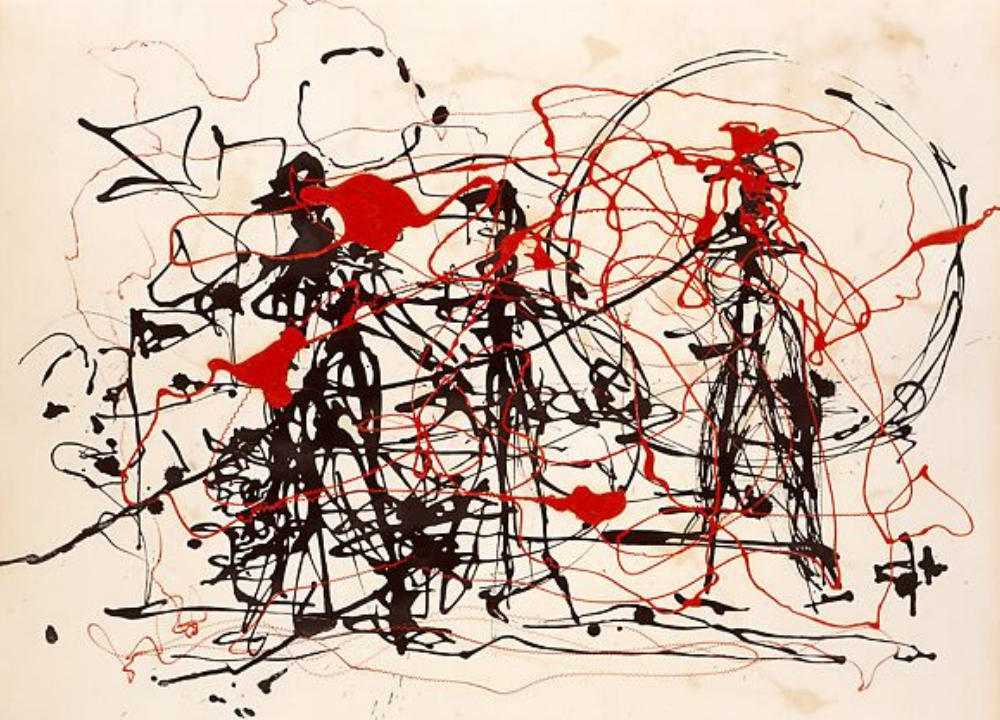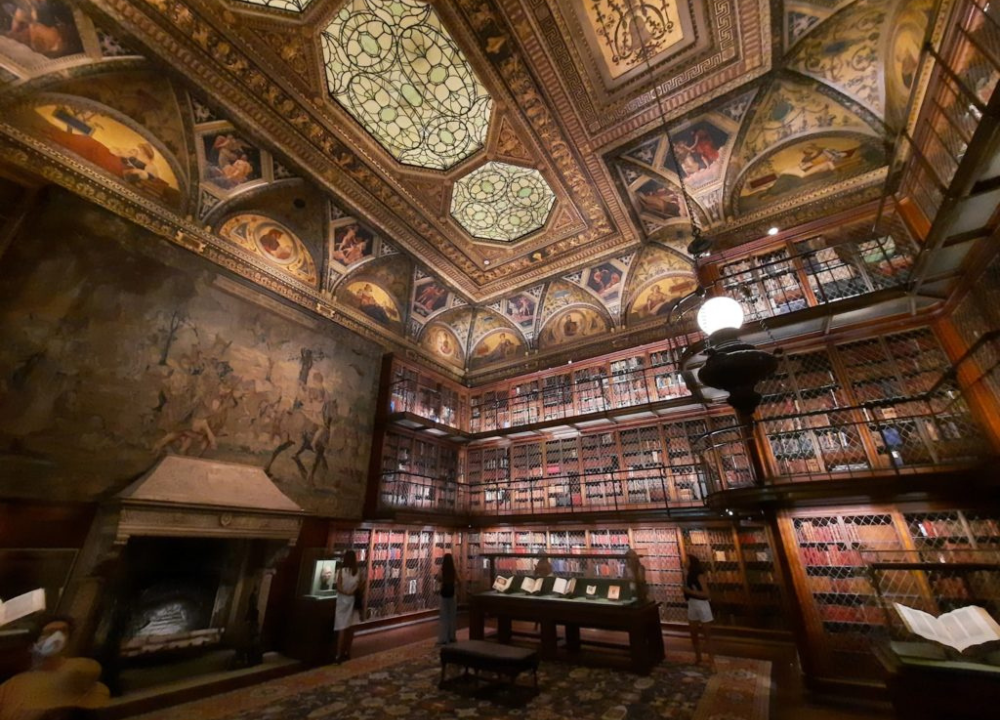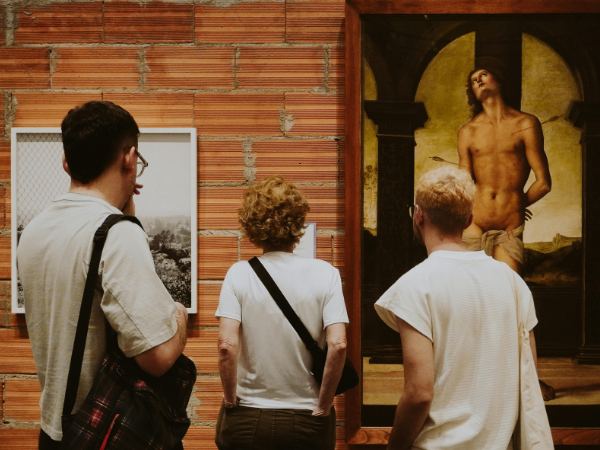Check his 3D and 2D exhibit @Eternal3D.com
5, 1948″ and “Autumn Rhythm (Number 30). ” His abstract expressionist paintings revolutionized the art world and continue to influence artists today.
Early Life And Education
When it comes to the world of modern art, Jackson Pollock is a name that cannot be overlooked. Known for his unique style of Abstract Expressionism, Pollock revolutionized the art scene with his unconventional techniques and powerful, energetic brushwork. To truly understand the artist behind the iconic paintings, it is crucial to delve into his early life and education. This section will explore Pollock’s childhood and family, the artistic influences that shaped his work, and his education and training.
Childhood And Family
Jackson Pollock was born in Cody, Wyoming, on January 28, 1912. He grew up in a moderately conservative family, with his father, LeRoy Pollock, working as a land surveyor, and his mother, Stella May McClure, a passionate amateur artist. Pollock had four siblings, and they lived a modest life in rural America.
Despite the hardships of the Great Depression, Pollock’s mother played a significant role in nurturing his interest in art. She encouraged his creativity and taught him the basics of painting. This early exposure to art and his mother’s support would prove to be vital in shaping his artistic journey.
Artistic Influences
Pollock’s artistic influences drew from diverse sources that left an indelible mark on his work. One of his primary influences was the Mexican muralist, David Alfaro Siqueiros. Siqueiros’s dynamic and politically charged murals left a profound impact on the young Pollock, inspiring him to experiment with unconventional techniques and explore social themes through his art.
Another significant influence on Pollock’s work came from Native American art. Growing up in the west, Pollock was exposed to the rich traditions of Native American cultures, where he found inspiration in the simplicity and expressiveness of their artistry. Their emphasis on storytelling through symbols and abstraction directly influenced Pollock’s artistic style.
Education And Training
Pollock’s formal education in art began when he moved to New York City in 1930. He studied at the Art Students League under the guidance of influential teachers, including Thomas Hart Benton and Stanley William Hayter. During this period, Pollock was exposed to various artistic styles and techniques, which he incorporated and transformed into his own unique approach.
A pivotal moment in Pollock’s artistic journey came when he discovered the work of the European Surrealists. Artists like Pablo Picasso, Joan Miró, and Max Ernst pushed the boundaries of traditional art, and their experimentation resonated deeply with Pollock’s desire to break free from artistic conventions.
Pollock’s education and training, combined with his innate talent and strong desire to challenge traditional norms, fueled his artistic evolution and set the stage for the groundbreaking works that would define his career.
Artistic Style And Techniques
Jackson Pollock, a renowned American artist, is best known for his unique artistic style and groundbreaking techniques. His abstract expressionist paintings, characterized by drips, splatters, and energetic brushwork, revolutionized the art world and left an indelible mark on modern art.

From his iconic work, “No. 5, 1948,” to the visually captivating “Autumn Rhythm,” Pollock’s biography and best works continue to inspire and captivate art enthusiasts worldwide.
Introduction To Abstract Expressionism
In the world of art, Jackson Pollock is revered as one of the pioneers of Abstract Expressionism. This movement emerged in the mid-20th century as a radical departure from traditional artistic styles. Abstract Expressionists aimed to convey emotions and experiences through the use of color, form, and gesture, rather than representing the physical world. Pollock’s innovative approach to painting captivated the art world, and his unique techniques continue to inspire artists today.
Drip Painting Technique
One of the defining aspects of Pollock’s artistic style is his drip painting technique. With this method, he would place a canvas on the floor, allowing for complete freedom of movement and expression. Using sticks, brushes, and even his own hands, Pollock would apply paint to the canvas through pouring, dripping, and splattering. The result was a vibrant and dynamic composition that captured the energy and spontaneity of the artistic process.
Elements Of Pollock’s Style
Pollock’s style can be characterized by several key elements. Firstly, his approach to composition was highly intuitive and unstructured. He would often work on a canvas from all angles, moving around it and layering paint to create a multi-dimensional effect. His use of bold colors and gestural brushstrokes added a sense of drama and immediacy to his works. Additionally, Pollock’s reimagining of the relationship between the artist and the canvas challenged traditional notions of control and precision in art-making.
| Characteristics | Description |
|---|---|
| Bold Gestures | Pollock’s sweeping brushstrokes and energetic movements on the canvas conveyed intense emotion and energy. |
| Raw Expression | Through his technique, Pollock aimed to tap into his subconscious and express his innermost thoughts and feelings. |
| Layered Complexity | Pollock often built up layers of paint, creating a sense of depth and texture that added richness to his compositions. |
Pollock’s unique artistic style and techniques revolutionized the art world, breaking away from traditional conventions and paving the way for future generations of artists to explore new realms of expression. His drip painting technique and innovative approach to composition continue to inspire and captivate art enthusiasts worldwide.
Career And Major Works
Jackson Pollock was a prominent American abstract expressionist painter known for his unique and groundbreaking artistic style. Throughout his career, he created a number of iconic paintings that continue to captivate audiences around the world. This section will explore the emergence of Pollock as an artist, key exhibitions he participated in, and some of his most famous paintings.
Emergence As An Artist
Pollock’s journey as an artist began in the 1930s when he studied under the renowned Regionalist painter, Thomas Hart Benton. Inspired by Benton’s teachings, Pollock began to develop his own style, which would later revolutionize the art world. His emergence as an artist came in the 1940s, during a period when abstract expressionism was gaining popularity.
Embracing this movement, Pollock started experimenting with new techniques, such as pouring and dripping paint onto canvas placed on the floor. This method allowed him to create dynamic and spontaneous compositions, breaking away from traditional painting conventions. Through his distinctive approach, Pollock aimed to capture the raw emotions and energy of the human experience.
Key Exhibitions
Pollock’s innovative style garnered attention and led to his participation in several key exhibitions. In 1943, he had his first solo exhibition at Peggy Guggenheim’s Art of This Century gallery in New York City. This marked a significant milestone in his career, as it helped introduce his groundbreaking technique to a wider audience.
In 1950, Pollock was invited to exhibit his work at the Venice Biennale, one of the most prestigious art events in the world. His participation in this international exhibition further solidified his reputation as a trailblazing artist. Pollock’s paintings were also prominently showcased in numerous American museums, including the Museum of Modern Art (MoMA) in New York.
Famous Paintings
Pollock’s famous paintings are characterized by their vibrant energy, gestural brushwork, and absence of recognizable subjects. One of his most renowned works is “No. 5, 1948,” which showcases his signature style of dripped and poured paint on a large canvas. This painting, with its expressive movement and rich layers, has become an emblematic example of abstract expressionism.
Another iconic piece by Pollock is “Autumn Rhythm (Number 30),” created in 1950. This dynamic composition features rhythmic patterns formed by the artist’s intuitive and spontaneous brushstrokes. The painting conveys a sense of movement and chaos, capturing the essence of Pollock’s unique approach.
Additionally, “Lavender Mist (Number 1)” is a well-known work that exemplifies Pollock’s ability to create a sense of depth and complexity through the layering of paint. The repetitive drips and splatters of color give the piece a sense of energy and vitality, offering a glimpse into Pollock’s abstract visual language.
In conclusion, Jackson Pollock’s career as an artist was characterized by his bold experimentation and innovative techniques. His emergence as a prominent figure in the abstract expressionist movement, participation in key exhibitions, and creation of iconic paintings have solidified his lasting impact on the art world.
Impact And Legacy
Jackson Pollock was a visionary artist known for his abstract expressionist paintings. His revolutionary technique of pouring and dripping paint created powerful and energetic artworks that left a lasting impact on the art world. Pollock’s best works, such as “No.
5, 1948″ and “Lavender Mist,” continue to inspire and captivate art enthusiasts today.
Influence On Contemporary Art
Jackson Pollock’s impact on contemporary art is immeasurable. His revolutionary technique of dripped and poured paint revolutionized the art world, laying the foundation for the Abstract Expressionist movement. Bold, dynamic, and uninhibited, Pollock’s paintings became a paradigm shift in the way art was experienced and created. His “action painting” approach, where he would energetically move around the canvas, dripping and flinging paint, not only transformed the physical process of making art but also challenged traditional notions of representation and technique.
Pollock’s influence can be seen in various forms in contemporary art. Many artists today draw inspiration from his unconventional methods and use of materials, incorporating similar techniques into their own works. Pollock’s emphasis on spontaneity, intuition, and experimentation has opened doors for innovation and liberated artists to explore their creative boundaries. His legacy persists in the way art continues to evolve and engage with the viewer on new levels.
Critical Reception And Controversies
The critical reception of Jackson Pollock’s work has been a subject of intense debate and controversy. While some immediately recognized its groundbreaking nature, others struggled to comprehend and appreciate his seemingly chaotic compositions. Pollock’s departure from figurative representation and his rejection of conventional artistic techniques challenged the establishment and initiated discussions around the definition and purpose of art.
His work was met with both enthusiastic praise and harsh criticism. Critics questioned the validity and skill involved in his paintings, often dismissing them as mere splatters and accidents. However, over time, as the true essence of Pollock’s art became more widely understood, critics and art enthusiasts began to embrace his contributions, recognizing the depth and meaning behind his seemingly abstract creations.
Controversies surrounding Pollock’s personal life and his struggles with alcoholism also influenced the reception and interpretation of his work. Some argued that his chaotic and frenetic style mirrored the turbulence within his own psyche, while others dismissed such correlations as overly simplistic. Regardless of opinion, there is no denying that Pollock’s paintings continue to evoke powerful emotions and challenge traditional notions of aesthetics.
Continued Popularity
Even decades after his untimely death, Jackson Pollock’s popularity and relevance have not waned. His works are celebrated in prestigious art institutions and continue to captivate audiences around the world. People are drawn to the energy, movement, and complexity within his canvases, seeking to unravel the depth of emotions conveyed through his abstract forms.
The accessibility of Pollock’s paintings, despite their abstract nature, is another reason for their continued allure. Viewers can engage with his art on an instinctual level, finding personal connections and interpretations without the need for strict narrative or representational elements. This accessibility has broadened the appeal of Pollock’s work to a diverse range of audiences, ensuring its enduring popularity across generations.
Personal Life And Struggles
When exploring the life of renowned painter Jackson Pollock, it becomes evident that his personal life and struggles played a significant role in shaping both his artistry and his legacy. Digging deeper into his biography unearths the intricate relationships, battles with alcoholism, and emotional turmoil that influenced his artistic journey. By delving into Pollock’s personal life, one gains a more profound understanding of the man behind the canvas.
Relationships And Marriages
Pollock’s personal life was marked by several influential relationships and marriages. One of the most impactful relationships was with fellow artist Lee Krasner, whom he met in 1941. Their partnership grew from mutual admiration to marriage, and Krasner became a vital source of support and inspiration for Pollock’s artistic endeavors. Together, they embraced a shared passion for avant-garde art and challenged each other to push creative boundaries.
Pollock’s relationship with Krasner was not the only significant one. His interaction with abstract expressionist artist and teacher Thomas Hart Benton was transformative and left a lasting impact on his artistic style. Benton’s guidance and mentorship provided Pollock with the foundation he needed to break free from traditional artistic conventions and develop his unique painting techniques.
Alcoholism And Emotional Turmoil
However, amidst these fruitful relationships, Pollock battled with alcoholism and emotional turmoil, both of which took a toll on his personal life and artistic career. Pollock’s alcohol abuse became increasingly prevalent as he struggled to cope with the pressures of artistic success and the weight of his own insecurities.
This destructive behavior not only strained his relationships, but it also had a significant impact on his mental and emotional well-being, leading to bouts of depression and self-doubt. Pollock’s emotional turmoil was often reflected in his paintings, as his chaotic brushstrokes and abstract compositions became a mirror for his internal struggles.
Impact On Artistic Career
The tumultuous nature of Pollock’s personal life had a profound effect on his artistic career. His battles with alcoholism and emotional turmoil ultimately led to a decline in productivity and artistic innovation. The once prolific artist struggled to find the same inspiration and energy that had propelled his earlier works.
While Pollock’s personal struggles took a toll on his art, they also contributed to his iconic style. The emotional depth and sense of vulnerability in his paintings resonated with audiences on a profound level. Pollock’s abstract expressionist works, such as his renowned “drip paintings,” conveyed a sense of raw emotion and intensity that captivated viewers and solidified his place in art history.
Despite the challenges he faced, Pollock’s personal life and struggles infused his art with a powerful authenticity that continues to captivate audiences to this day.
Death And Posthumous Recognition
Jackson Pollock, an influential abstract expressionist artist, gained posthumous recognition for his revolutionary painting techniques. Known for his dripped and poured paint style, Pollock’s best works include “No. 5, 1948” and “Lavender Mist. ” His biography reveals a troubled artist whose artistic legacy continues to captivate audiences worldwide.
Tragic End
Jackson Pollock’s life came to a tragic end on August 11, 1956, when he died in a car accident at the age of 44. This unfortunate event marked the untimely demise of a pioneering artist, known for his unique style of abstract expressionism. Despite the brevity of his career, Pollock left an indelible mark on the art world.
Posthumous Exhibitions And Achievements
After Pollock’s death, his work continued to gain recognition and appreciation. In 1958, the Museum of Modern Art in New York organized a major retrospective exhibition of his paintings, solidifying his status as a significant figure in modern art. This exhibition showcased not only his famous drip paintings but also provided an overview of his artistic evolution.
In the years following his death, many other exhibitions were dedicated to Pollock’s art, both in the United States and internationally. These exhibitions allowed a wider audience to experience the power and intensity of his work firsthand. It was through these posthumous exhibitions that Pollock’s artistic legacy continued to thrive and captivate art enthusiasts.
Moreover, Pollock’s achievements extend beyond exhibitions. In 1973, one of his famous drip paintings, titled “No. 5, 1948,” fetched a record-breaking price of $2 million at an auction. This sale marked a turning point in the art market, highlighting the immense value placed on Pollock’s oeuvre.
Long-term Influence
Pollock’s impact on the art world extends far beyond his own lifetime. His avant-garde approach to painting, characterized by his unconventional techniques and the absence of traditional subject matter, revolutionized abstract expressionism. His unique style continues to inspire and influence artists to this day.
Pollock’s emphasis on the process of creating art rather than the final product challenged conventional notions of artistic creation. He pushed the boundaries of the medium and shattered preconceived notions of what abstract art could be. His innovative techniques, such as dripping, pouring, and splattering paint onto the canvas, opened up new possibilities for artistic expression.
This groundbreaking approach paved the way for future generations of artists to explore new avenues of artistic experimentation. Pollock’s legacy can be seen in the works of contemporary artists who continue to push the boundaries of abstraction and redefine the art world’s perception of what constitutes art.
Frequently Asked Questions For Biography And Best Works Of Jackson Pollock
What Is The Best Biography Of Jackson Pollock?
The best biography of Jackson Pollock is “Jackson Pollock: An American Saga” by Steven Naifeh and Gregory White Smith.
What Was Jackson Pollock’s Most Famous Painting Called?
Jackson Pollock’s most famous painting is called “No. 5, 1948”.
What Is So Great About Jackson Pollock?
Jackson Pollock is renowned for his unique style of abstract expressionism, where he dripped and poured paint onto canvases. His energetic and spontaneous compositions captivate viewers, evoking emotions and allowing for individual interpretation. Pollock’s innovative approach revolutionized the art world, making him one of the most influential artists of the 20th century.
What Are Jackson Pollock’s Major Accomplishments?
Jackson Pollock’s major accomplishments include pioneering the abstract expressionist movement, creating unique drip painting techniques, and gaining international recognition for his artwork. He was known for his influential artistic contributions in the mid-20th century.
Conclusion
Jackson Pollock is a renowned artist known for his revolutionary abstract expressionist works. His unique painting technique, characterized by pouring and dripping paint onto canvas, created dynamic and energetic compositions that captivated the art world. With masterpieces like “No. 5, 1948” and “Autumn Rhythm,” Pollock’s influence on contemporary art remains undeniable.
Delve into the fascinating life and groundbreaking art of Jackson Pollock to appreciate his lasting legacy in the art world today.




